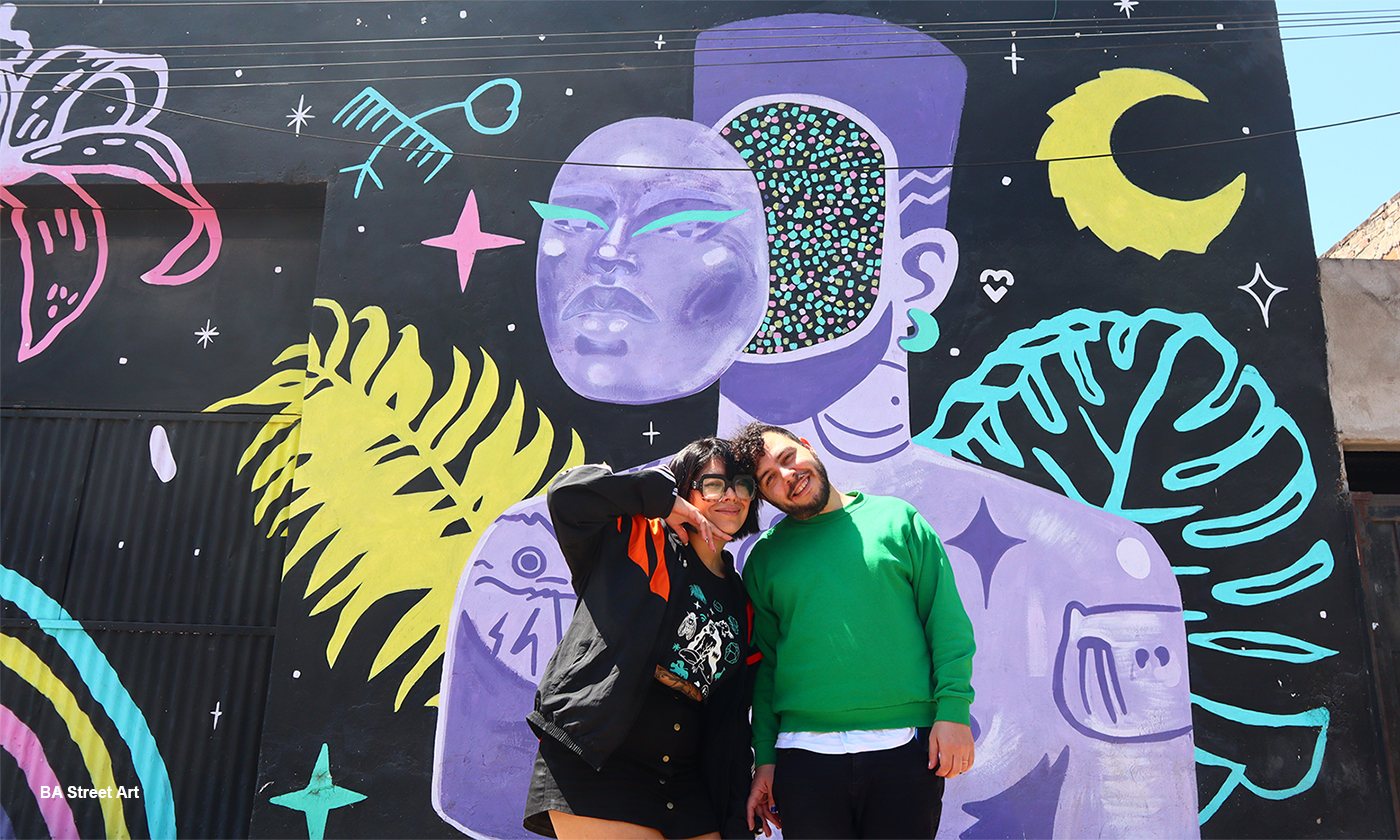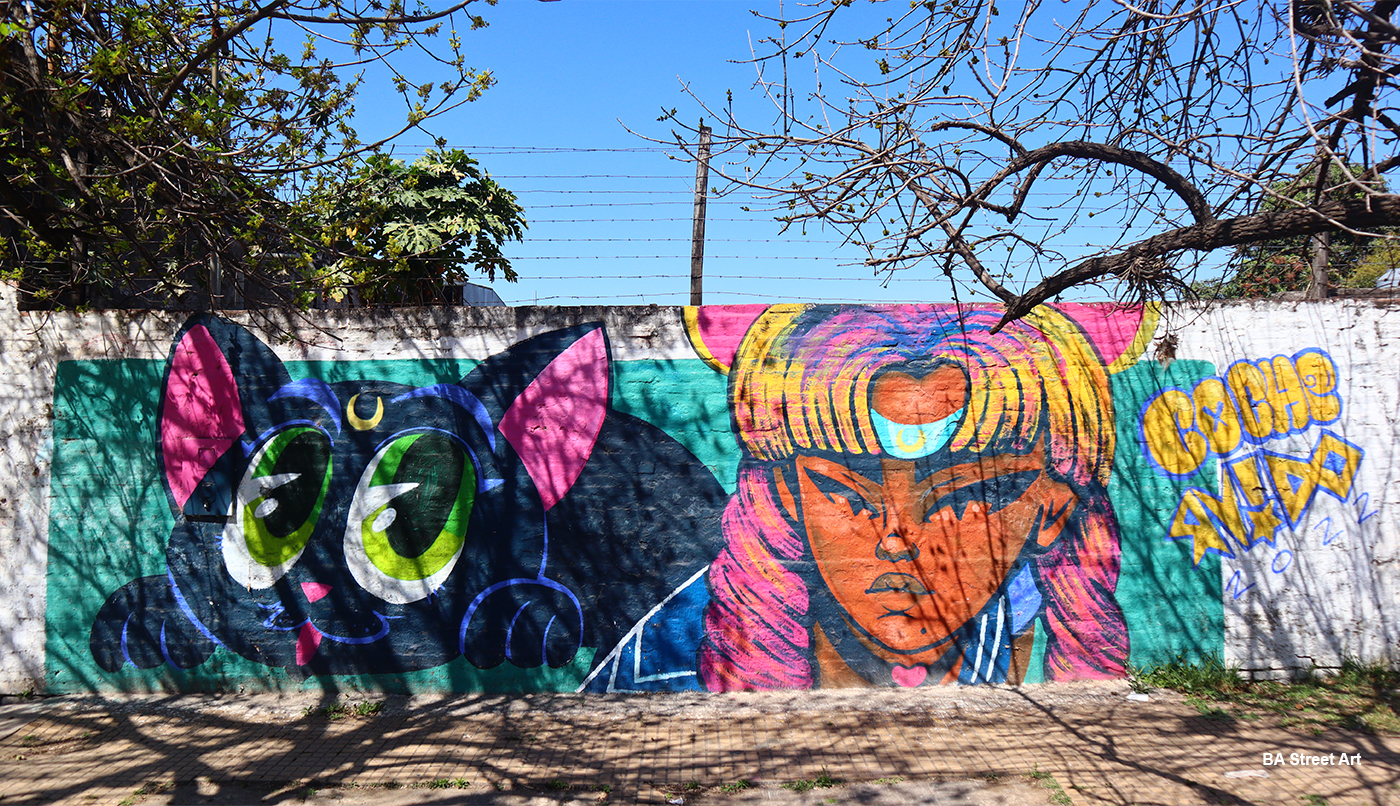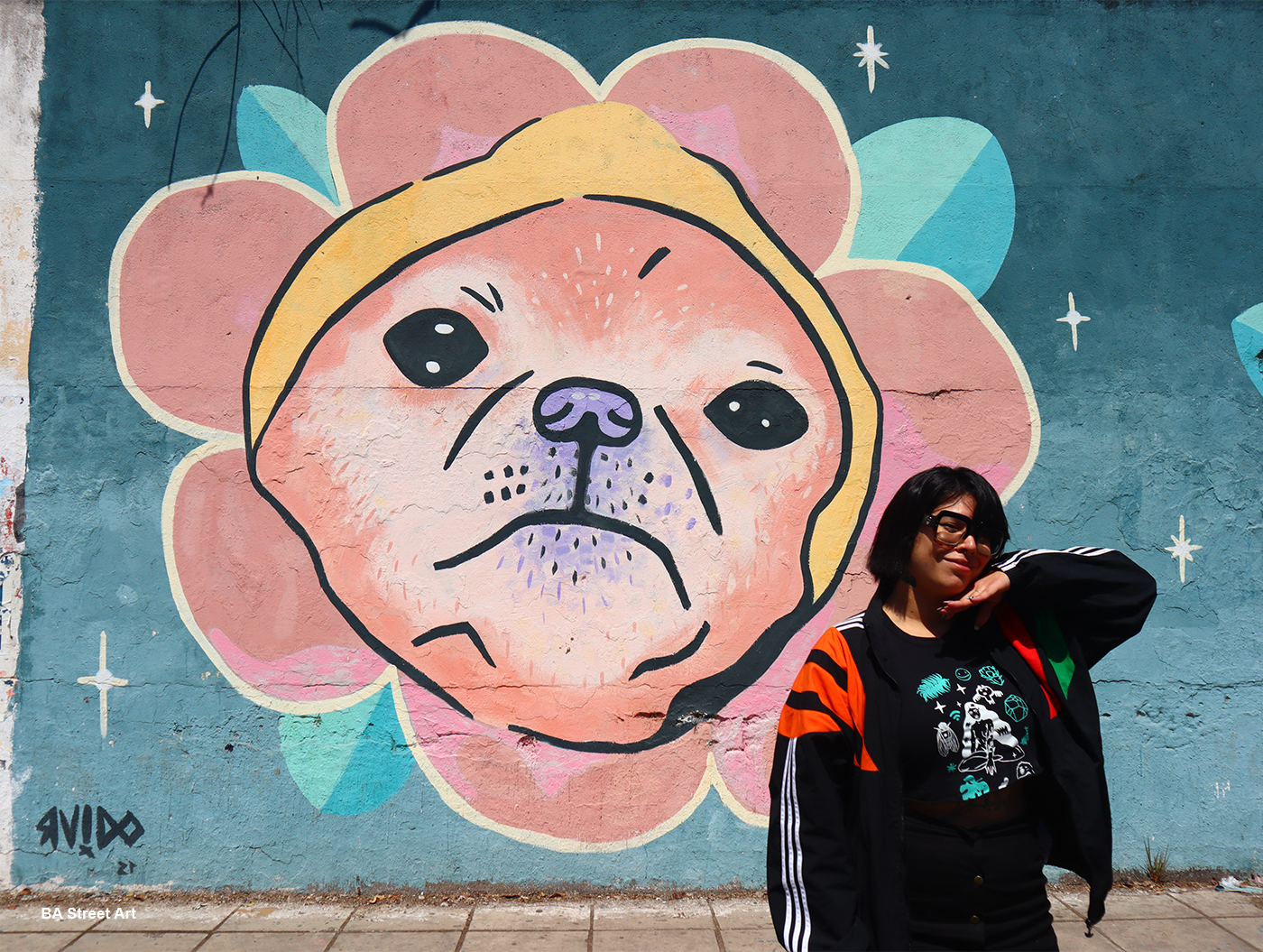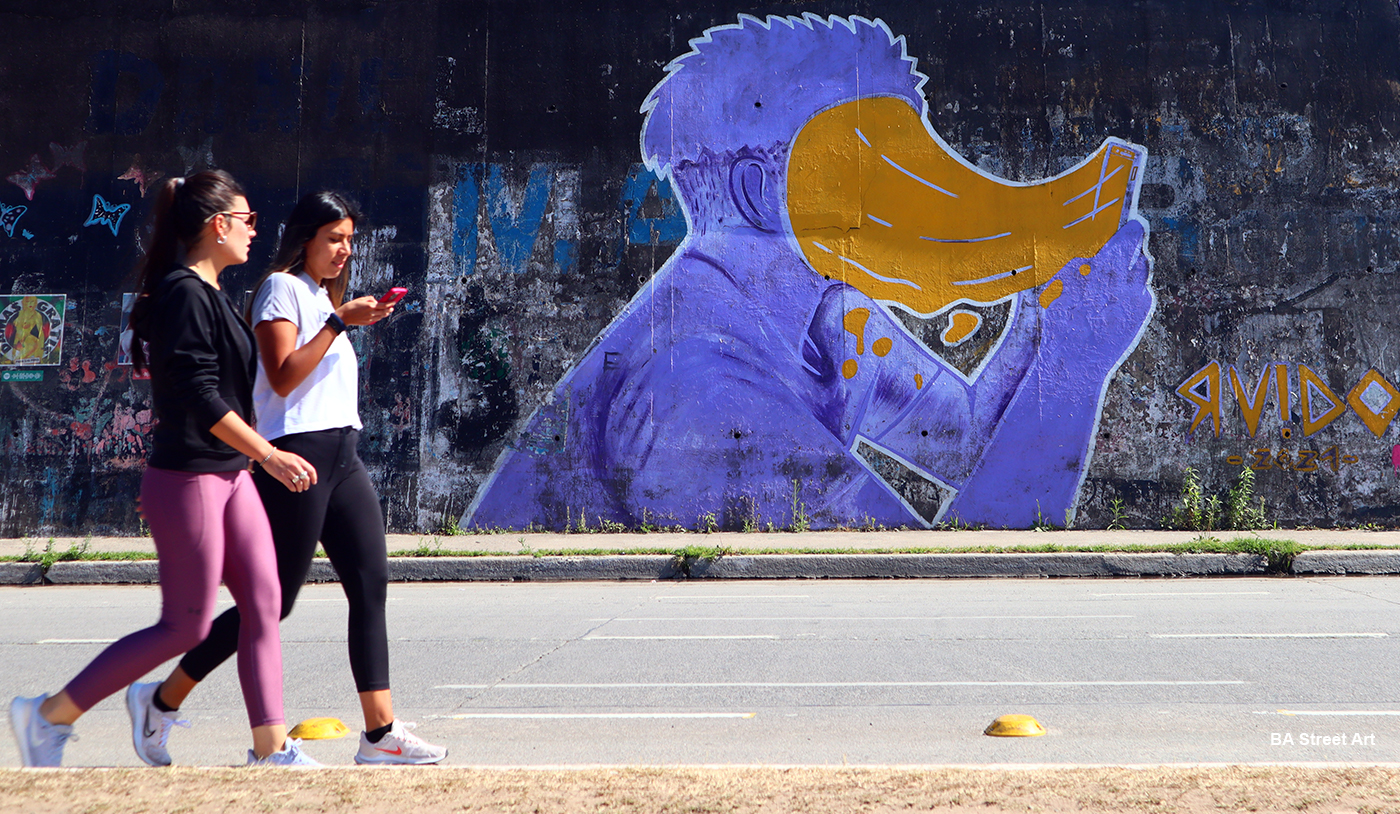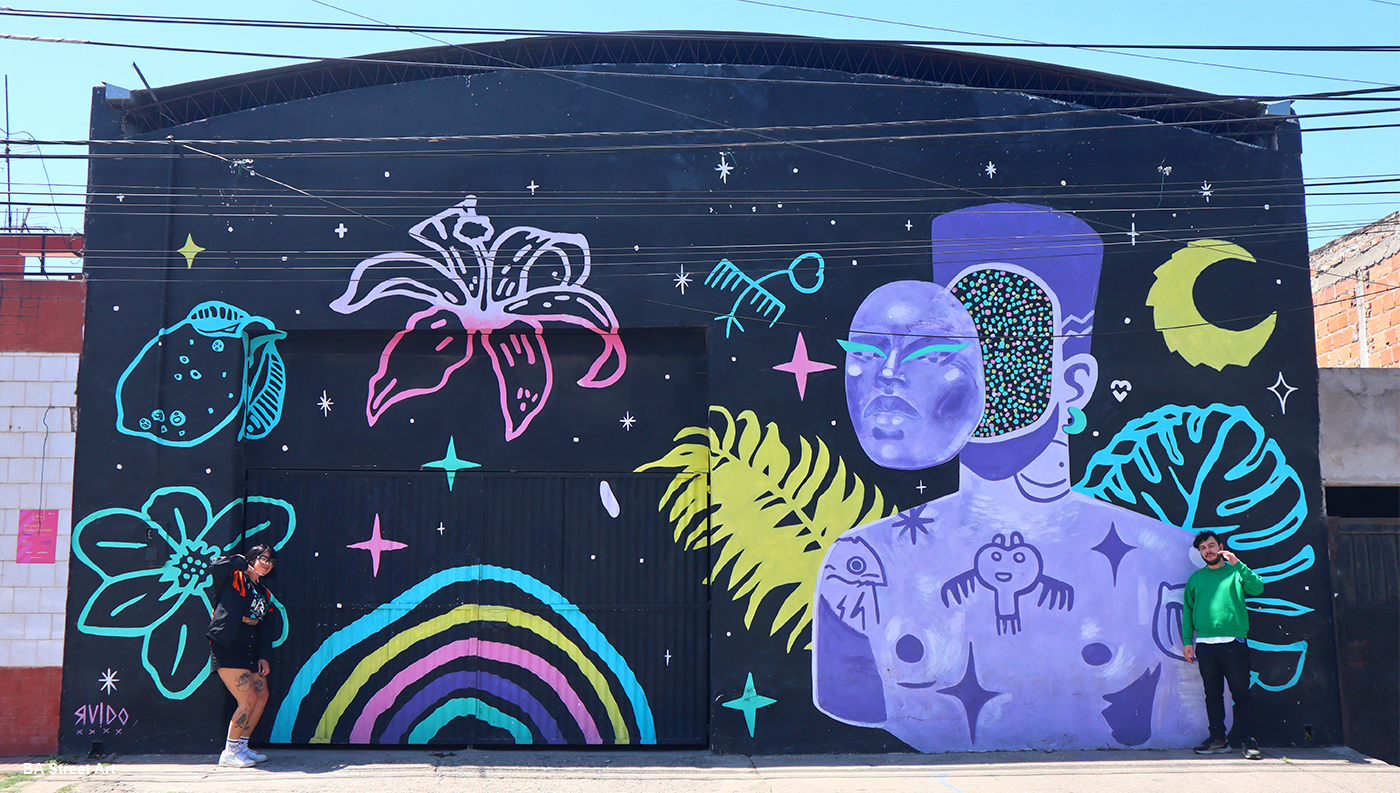Street artists Vero Corrales and Fer Gallucci are not only transforming the urban landscape in Tucumán by painting colourful and creative murals over political propaganda that is scarring the city but are also changing people’s way of thinking.
The duo, who form the artistic group Ruido (also helped by Vero’s sister Dolores Corrales who documents their murals), spoke with Buenos Aires Street Art about why they paint over political propaganda, their mural that a Catholic priest tried to censure, street art relating to government Covid measures, and why they are not afraid of tackling topics sensitive topics like prejudice and homosexuality in a conservative society.
Vero says her artistic influences come from “a mix of everything” including illustration, traditional graffiti and comics. As a multi-disciplinary artist she uses different techniques and formats to create artworks, sculptures and textiles, as well as murals. She first started painting in the street in 2014 with local street artists such as Coche, Nacho Stesina, Ludmilla Ríos Guillen, Fabro Paredes and Luciano Vita. “With these guys, I’d go out once a week and later every weekend practicing how to paint and we’d practice, paint and have a great time,” Vero recalls. “I then started painting over political propagandas with Fer in 2020.”

Signal box – collaboration with characters painted by Cuore, Coche, Ruido & Ludmilla Ríos Guillen (photo © BA Street Art)
Fer first developed a real interest in street art after spending three months in Mexico City. CDMX is regarded as one of the best cities for urban art in the world with its rich tradition of Mexican muralism passed down by Diego Rivera, David Alfaro Siqueiros, and José Clemente Orozco. When Fer is not painting murals with Vero, he’s working as a script writer, director and sound engineer, and is a professor of sound engineering at the University of Tucumán Cinema School.

Political propaganda that dirties the walls of the city of San Miguel de Tucumán is everywhere (photo © BA Street Art)
I first visited San Miguel de Tucuman in the north of Argentina in 2014. On almost every street corner, even on some old and historic buildings, were the names of political leaders like Alperovich or Kirchner and names of political parties painted in giant letters. Argentina’s most famous architect Cesar Pelli, who designed the stunning Petronas Towers in Kuala Lumpur, was born in Tucumán. There isn’t even a building he designed in the province to remember his legacy. He’d be sick at how political parties have ruined the walls of his city.

Making noise – cartoon character painted on top of names of Alberto Fernandez, Cristina Kirchner & Juan Manzur (photo © BA Street Art)
Ruido have made it their quest to paint over political propaganda in Tucumán with humorous, fun and thought-provoking artworks that also tackle prejudices and stereotypes in a conservative society. Vero estimates Ruido have painted over more than 50 political propagandas around Tucumán in the last two years.
‘A good quality mural is always much better perceived than political propaganda’
“Sometimes we ring doorbells but if there is a political propaganda on a wall, we don’t ask permission,” admits Fer. “We use the same method as those who paint the political propaganda with total impunity. A good quality mural is always much better perceived than political propaganda and if the wall belongs to local residents we always ask first and get permission to paint.”
‘Mafia message’
And Fer feels strongly about the damage that it’s doing to the city. “I’m not sure exactly where the culture to paint political propaganda came from but from my point of view I see it as a mafia message more than a political one, where each politician paints in a pre-determined neighbourhood. They often paint the name of just one politician that they then replicate in all the district so that there is no other. They are saying: ‘this is my neighbourhood, don’t mess’. So more than a political message, it’s a mafia message.”
Another fun mural by Coche and Ruido painted on top of a political propaganda mocks the elections, naming the artists themselves as nominees for governor and vice governor. “Just in front of the mural were two advertising billboards paid for by a political party,” remembers Fer. “The two faces in the ads were very similar to the ones we decided to paint – so we decided Coche and Ruido would be the two best alternative candidates to vote for!”
Ruido also launched a campaign on social media inviting their followers to get in touch if they have a wall on which they’d like a mural painted. Ruido say it’s not easy to secure sponsorship from paint stores so often they use their own funds, materials donated by local residents and paint left over from other art projects to finance their murals. Many property owners are also happy to contribute towards the costs of the artwork by donating paint and materials. Vero admitted that they sometimes get frustrated that the artworks they’ve painted don’t last longer. “There are many murals that we’ve painted and political groups have returned in a few weeks to paint their slogans again,” she said. “‘What do people think?’ They tell us they don’t like it that politicians and political parties are dirtying the walls of the city with their names and that they would rather see interventions that are genuinely artistic.” She added: “Many people send us a lot of messages of support, and our followers (on social media) sometimes send us photos of our murals being painted over by these political groups and they want us to paint new ones.”
Cats & Dogs

Mural by Ruido & Ludmilla Ríos Guillen in Yerba Buena with laughing cat & farting dog (photo © BA Street Art)
Ruido have also painted dozens of murals of cats and dogs around Tucumán. One along Avenida Mate de Luna, the most important road in Tucumán province, depicts a smiling cat and farting dog. Vero says: “It was a political propaganda before and we painted over it completely. It could be a cat laughing or sneezing – depends on who sees it and how they interpret the mural.”

Mural by Coche, Cuore Mariano Orell, Evanfelino & Ruido in San Miguel de Tucumán (photo © BA Street Art)
Vero also revealed that Ruido also like to paint cats and that the word ‘gato’ in Spanish (meaning cat) also has another meaning. She said: “People use the word ‘gatos’ to describe criminals and associate this word with politicians because it’s said they are corrupt and steal.”
Church tries to censure Ruido mural
Ruido also painted a great mural in June 2022 in Villa Obrera, Tafi Viejo that took them five days to complete. Despite the the artists being given permission by the local government to paint the wall that was in a bad state of repair, it didn’t stop the local parish priest wanting to cover it over with white paint.
Vero said the mural was dedicated to a girl from the neighbourhood named Tatiana who was murdered in 1999 . She said neighbours loved the idea of painting a mural as a tribute and the design for the artwork was also approved by the girl’s mother. “Local residents came up to us and told us about what happened,” said Vero. “Now Tatiana lives on in the memory of the neighbourhood.”
The church of Nuestra Señora del Valle in Villa Obrera wanted to censure the artwork on the grounds that it was offensive to Christians. “The priest was saying the the mural was diabolic – he was saying the purple colour is related to the devil and insulting,” exclaimed Vero. “Priests and bishops themselves wear purple robes and clothing but the colour actually relates also to spirituality and wisdom.” She added: “It was just crazy what the priest was saying. What the Church really wanted to do was censure the mural. The artwork is related to the place and is about childhood, innocence, caring for animals and a fitting tribute, we all think, to a young girl who lost her life. She is cuddling her dog! There is nothing evil about it whatsoever.”
She added: “Neighbours and friends organised a signed petition to save the mural and fortunately common sense prevailed.”
Murals relating to Covid
In March 2020, Argentina underwent one of the longest Covid quarantines in the world with government restrictions on freedom of movement, outdoor exercise was banned and people were only allowed out of their homes to buy food or go to a pharmacy to get medicine. Covid measures in Tucumán were equally as tough with borders to the province closed and roadblocks set up to prevent non-residents from entering. Social distancing and the wearing of face masks were also made compulsory in open and closed spaces.
And Fer recalls the quarantine was the catalyst: “Obligatory confinement as it’s officially called in Argentina, or at least in Tucumán, was really strict and people respected it a lot. We found it really tough being locked down and having to spend so much time inside affected us a lot. So we decided to go out together and paint in the street.”

Couple embracing wearing face masks in a mural painted on top of of politicians’ names (photo © BA Street Art)
The duo painted a series of eye-catching murals around the city featuring characters wearing face masks and plastic visors. Fer admitted that they were probably breaking the law at the time. ” They (the government) call it obligatory confinement, so we had to stay at home. So in one sense we committed a crime because we weren’t allowed out. The idea of us painting people with masks was because we wanted to record and make more visible what was happening at the time.”

Government Covid propaganda in Tucumán telling people to stay in their homes (photo © BA Street Art)
“The face mask itself is actually a type of censorship and covering up one’s mouth is also very symbolic,” states Fer. “When the obligatory confinement started many people lost their jobs and had to change the course of their lives. DJs or musicians for example weren’t allowed to perform live so had to find some other way to make money. There was also a lot of uncertainty as nobody knew how long this situation was going to go on for.”
Vero, who is also a multi-disciplinary artist creating tattoos, sculptures and works in different formats, revealed that despite being in the open air, Ruido were painting with face masks on: “We’re human beings, so needed fresh air and to be outside. We wore the face masks just in case the police came when we were painting. It was more to not get into trouble anyone than anything else.”
Vero said passers-by and the public only had positive comments about their murals featuring masks: “People only had nice things to say – the truth is that most people are tired of seeing political propaganda and advertisements. What we were painting has a more human side with touching moments and the idea was to change their daily routine.”
Football violence
Football in Tucumán, like in most provinces in Argentina, has a huge following. The two biggest football clubs in Tucumán are San Martin and Club Atlético Tucumán. No problem then painting a mural of two rival fans wearing the shirts of their respective clubs while kissing each other?
Fer explained: “We painted a mural in 2020 featuring a fan of San Martín and the other with the shirt of Atlético kissing one another. It generated a lot of repercussions and internet haters were accusing us of encouraging homosexuality. I grew up as a fan of San Martin but I don’t like the violence or the chauvinism in football and I no longer identify myself with the sport in general.”
Vero admitted she’s also against the violence in football. “A few years ago a football supporter was murdered in Tucumán. I used to live in Santiago de Estero, one block away from the stadium of Club Atlético Mitre. I remember when I was a child, we had to close the windows because rival fans were shooting at each other and the police came and started spraying tear gas.” She added: “Many people told us they really liked this mural. Our message was first of all against all violence in football and wasn’t really related at all to homosexuality but some people were interpreting it as two gay men kissing.”
A few days after finishing the mural, a group of fans from San Martín came and changed the colors of their team’s shirt. On top of the red and white they painted light blue and white, leaving both fans depicted in the mural with the similar tones. Fer said he wasn’t that surprised: “I guess the mural touched the masculinity of many people. And for me, in general it’s not so bad that different sexual tendencies are given some place or attention because we are in the year 2022, after all! However, in our society (in Tucumán) it’s as if love and kisses are a heterosexual privilege and for that reason it’s frowned upon that two people of the same sex are seen holding hands or showing affection towards one another.”

Masculinity – long hair then added on top of one of the characters & artists’ name painted over (photo © BA Street Art)
Fer said: “There’s still a lot of homophobia in the province of Tucumán. It’s because we are still a very conservative society. Also the Christian, Catholic and apostolic faith is in our constitution and that’s a part, I think that’s one of the reason why gay guys and lesbians and dissenters are often treated so differently.”
Cellphones & toxic relations
The addiction and overuse of cellphones is a topic that Ruido have also tackled in their murals painted around Tucumán. “These murals we painted in 2020 and 2021 as part of a series called ‘Relación Toxica’ (or ‘Toxic Relationship’) with mobile devices which was all about questioning and criticising people’s relationship with mobile devices and the new dynamic of connectivity that these devices offers,” Vero explained. “We painted these murals in these spots on busy avenues and streets around the city centre because we know they are places where a lot of people pass by.”
There are studies which show that excessive use of cellphones are a type of addiction to technology that can contribute to developing attitudes such as dispersion, stress, anxiety and intolerance.
Mural circuit
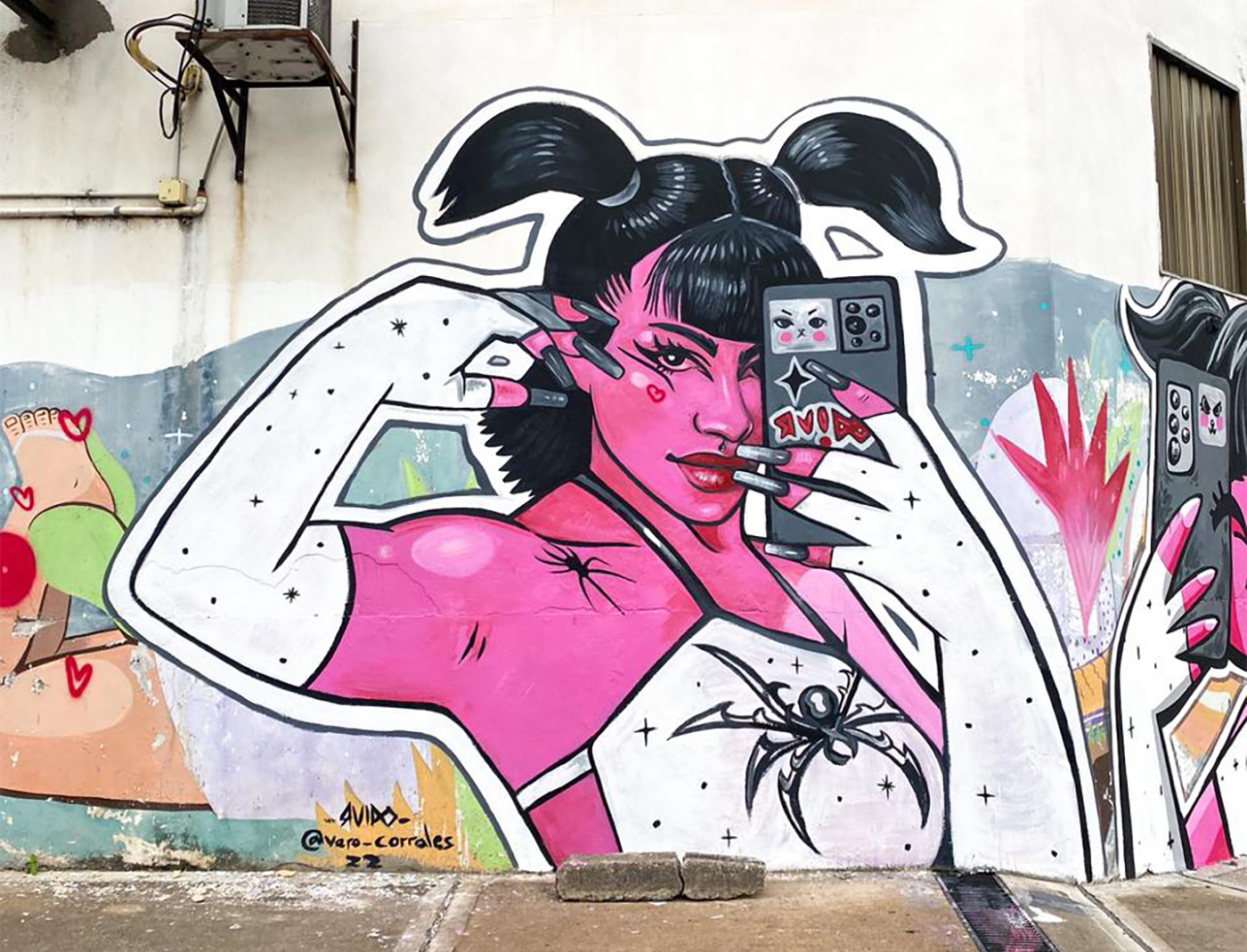
New portrait of Argentine rapper Cazzu by Vero Corrales in San Miguel de Tucumán (photo © Vero Corrales)
Ruido told Buenos Aires Street Art that they have been organising a cool new project called ‘Circuito Ruido’ to create a circuit of murals around Tucumán province and the north of Argentina. The circuit consists of 70 murals, so far, between the provinces of Tucumán, Santiago del Estero, Catamarca, Jujuy, San Juan, San Luis and also Buenos Aires. Other artists who have participated are Ludmilla Ríos Guillen, Nacho Stesina and Sr Junco. Places where Ruido have painted and organised murals in Tucumán include Yerba Buena, Barrio Sur, Tafi Viejo, Lules, Concepción and Bella Vista.

Collaboration between Ruido, Coche & Ludmilla Ríos Guillen in Santiago del Estero (photo © Vero Corrales)
“When Vero and I started to paint in the street together, our first idea was to create a museum under the open sky so that people could appreciate urban art on a large scale without the necessity to buy a ticket,” recalls Fer.
“Tucumán is particular as for many years it’s had a university of arts and philosophy and there are a lot of young people who have studied there; and having an arts school I think generates a general a real appreciation for the the arts. Also in Tucumán ,there are a lot of artists but not so many art galleries or museums. Hence, there isn’t much space for artists to express themselves away from these traditional circuits. There is a general respect and appreciation of street art from the public but the attitude of the local government in Tucumán is that they don’t value arts and culture much hence urban artists don’t get the respect they deserve.”
Vero added: “The intention (of ‘Circuito Ruido’) is to beautify distinct urban points in the region, generating a touristic, artistic and cultural circuit by painting murals, intervening in and regenerating abandoned spaces, most of which, are a long way off from being recovered by their owners or the state. Many of these places have been used as rubbish dumps or ‘expropriated’ by political propaganda, advertising or vandalism so the idea is to give them a facelift creating a touristic and urban route like an open air museum.”
Check out more artworks by Vero & Fer at www.instagram.com/vero_corrales/
Photos and interview © Buenos Aires Street Art

